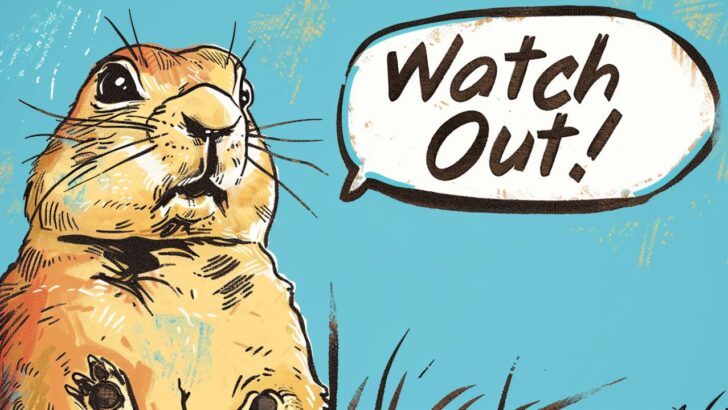Picture this: you’re eavesdropping on a secret meeting of the animal kingdom, where prairie dogs are gossiping, dolphins are calling each other by name, and elephants are sharing stories through rumbles. It sounds like something out of a Disney movie, right? Well, it turns out animals have some pretty wild ways of communicating that put our human small talk to shame.
From bee dances to octopus color codes, join us as we decode the clever languages of our furry, feathered, and finned friends.
Prepare for a wild linguistic safari; it will be a hilarious and enlightening adventure!
1. Prairie Dog Vocabulary
Imagine strolling through a prairie, when suddenly you hear a series of chirps and barks. You might think it’s just random noise, but in reality, the prairie dogs are having a neighborhood watch meeting. These tiny rodents have an impressively complex language that can describe not only predators but also details like their size, shape, and even the color of their clothes!
If a human wandered into their turf, prairie dogs might as well be calling out, “Watch out! Two-legged creature, medium height, wearing a red shirt!” Next time you see a prairie dog, remember—they’re the town gossips of the animal world.
2. Dolphin Communication
Picture this: a dolphin swimming through the ocean, chirping and whistling. What you might not know is that these sounds are more than just underwater small talk. Dolphins actually use unique whistles to call each other by name! It’s like they’ve got their own aquatic version of name tags.
So, when Flipper is looking for his buddy, he doesn’t just whistle aimlessly; he calls out, “Hey, Bubbles!” and Bubbles knows exactly who’s calling. It’s basically the dolphin equivalent of shouting across a crowded room, but way cooler and a lot more graceful.
3. Elephant Rumbles
Next time you feel chatty, take a cue from elephants, the original long-distance communicators. These majestic giants use low-frequency rumbles to send messages that can travel miles through the ground. Forget cell phones; elephants have their own underground network.
These seismic signals convey everything from “Hey, there’s water over here!” to “Danger ahead, folks!” It’s like having a secret Morse code, but way cooler and without the need for opposable thumbs. Elephants: proving that good communication doesn’t need words.
4. Bee Dances
Bees have taken the concept of interpretive dance to a whole new level. When a honeybee discovers a great patch of flowers, it returns to the hive and performs the “waggle dance.” This isn’t just any dance; it’s a full-on GPS, complete with directions and distance to the food source. The bee shakes its abdomen and waggles in a figure-eight pattern, giving the hive a precise map to the floral jackpot.
It’s like having a dance-off where the prize is nectar and everyone wins.
5. Birdsong Dialects
7. Octopus Color Changes
Octopuses are the chameleons of the sea, but their color-changing skills go beyond camouflage. These intelligent invertebrates use color changes to communicate their emotions and intentions. Feeling threatened? They might flash a dark hue. Ready to mate? Expect a dazzling display of colors. It’s like having a mood ring built into their skin.
With thousands of color-changing cells called chromatophores, octopuses can express themselves in a vivid, silent language that’s as beautiful as it is mysterious. Talk about wearing your heart on your sleeve—literally!
8. Bat Echolocation
When it comes to navigating in the dark, bats are the true superheroes. They use echolocation, emitting ultrasonic sounds that bounce off objects and return as echoes. This allows them to “see” their surroundings with their ears, creating a detailed mental map of their environment. It’s like having built-in sonar, helping them catch insects mid-flight or avoid obstacles.
Imagine being able to walk around a pitch-black room without bumping into anything—bats do this every night, proving they’re the ultimate nocturnal navigators.
9. Chimpanzee Gestures
Chimpanzees are the masters of body language, boasting over 60 distinct gestures to communicate with each other. From a simple hand wave to an elaborate arm raise, these gestures can mean anything from “Let’s play” to “Give me that food.” It’s like they have their own sign language, filled with nuanced expressions and meanings.
Researchers have even found that many of these gestures are shared across different chimpanzee groups, suggesting a universal chimp communication system. So next time you see a chimp at the zoo, remember—they’re probably having a sophisticated conversation without saying a word.
10. Ant Chemical Trails
Ants might seem like simple creatures, but they have an impressively sophisticated chemical signal communication system. When an ant discovers food, it releases pheromones on its return trip to the colony, creating a scented trail that guides other ants to the bounty. This pheromone highway is like an invisible GPS, directing the entire colony efficiently to the food source.
It’s an odor-based messaging system that keeps the colony connected and ensures everyone gets fed. So, while they might be tiny, ants are masterful communicators with a highly effective chemical language.

Hey fellow Linguaholics! It’s me, Marcel. I am the proud owner of linguaholic.com. Languages have always been my passion and I have studied Linguistics, Computational Linguistics and Sinology at the University of Zurich. It is my utmost pleasure to share with all of you guys what I know about languages and linguistics in general.

